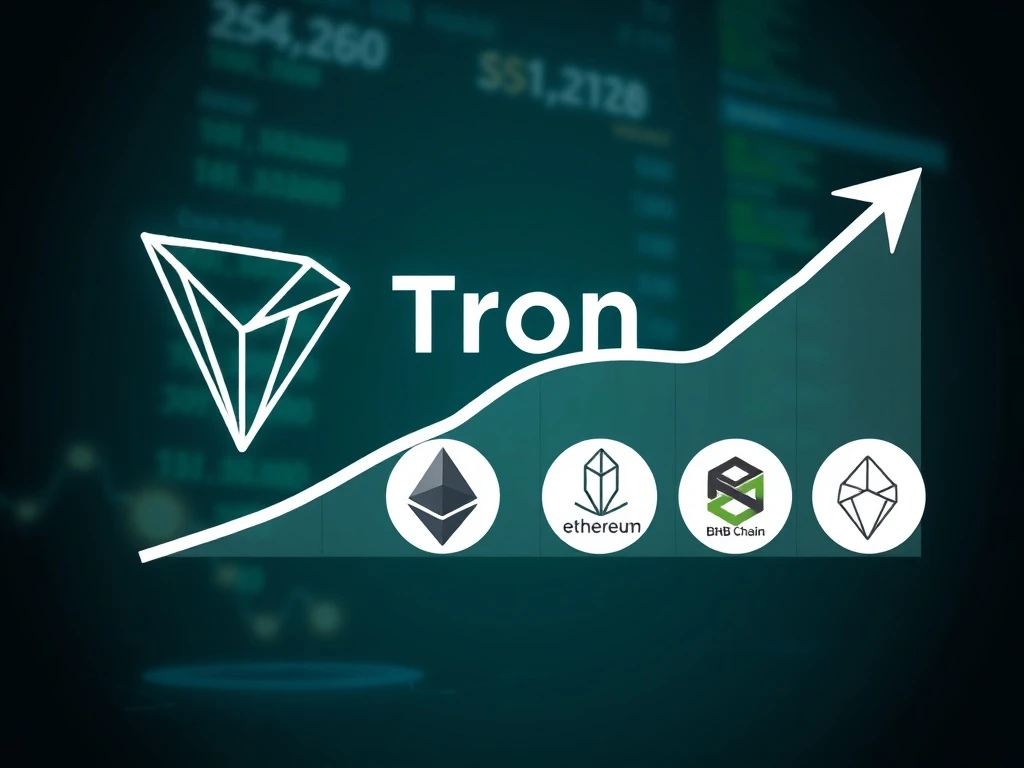Crucial Tron Gas Fee Reduction: Unpacking the 64% Revenue Impact and Market Dominance

The cryptocurrency world constantly evolves, with networks frequently adjusting their operational parameters. Recently, Tron, a prominent Layer-1 blockchain, implemented a significant change to its fee structure. This crucial Tron gas fee reduction has dramatically altered its daily revenue landscape, creating ripples across the ecosystem. Investors and users alike are observing the implications of this strategic move, which has seen a substantial drop in earnings for the network’s block producers.
Understanding the Tron Gas Fee Reduction
Tron’s recent fee adjustment directly impacts the costs associated with network transactions. Specifically, the network slashed the energy unit price from 210 sun to 100 sun. Gas fees represent the transaction costs users pay on the Tron network. They are measured in sun, Tron’s smallest unit, where one TRON (TRX) equals one million sun. This change stemmed from Tron Proposal #789, titled “Decrease the transaction fees.” The Super Representative community voted for this proposal, which went live on August 29.
The proposal’s initiator, community member GrothenDI, argued for lower transaction fees. He suggested that such a reduction would foster the “sustainable and healthy development of the Tron ecosystem.” GrothenDI projected that cutting gas fees to 100 sun could attract an additional 12 million potential transfers from users. This proactive step aims to enhance network accessibility and encourage greater participation, ultimately benefiting the entire ecosystem.
Dramatic Decline in Tron Revenue
Following the implementation of the new fee structure, Tron experienced a significant decline in its daily network fees. A new report from CryptoQuant highlights this impact. The total daily network fees for Tron’s block producers, known as Super Representatives, plummeted to $5 million on September 7. This marked the lowest level in over a year. Before the lower fees were implemented, daily revenue stood at $13.9 million. Consequently, this represents a substantial 64% Tron revenue decline in just 10 days.
This sharp reduction directly correlates with the decreased average gas fees on Tron. Onchain data confirms that average gas fees have fallen by 60% since the network adopted the proposal. While the fee reduction benefits users by making transactions cheaper, it simultaneously reduces the income generated for those maintaining the network. This trade-off between user cost and network income is a critical consideration for blockchain sustainability.
Tron’s Enduring Dominance Among Layer-1 Blockchains
Despite the notable decrease in its daily earnings, Tron remarkably maintains its leading position among Layer-1 blockchains in terms of revenue. Data from Token Terminal reveals this continued dominance. Over the past seven days, Tron captured an impressive 92.8% of the total revenue generated by Layer-1 networks. This figure places it significantly ahead of major competitors such as Ethereum, Solana, BNB Chain, and Avalanche. This sustained lead underscores Tron’s robust network activity and extensive user base, even with reduced transaction costs.
Looking at a broader timeline, fees generated from transactions on Tron amounted to $1.1 billion over the past 90 days. This substantial figure further solidifies its market presence. While Ethereum has historically led revenue generation over the past five years with $13 billion, Tron follows with a significant $6.3 billion. This comparison highlights Tron’s strong performance and its ability to compete effectively in the highly competitive Layer-1 space. The fee reduction strategy, therefore, aims to bolster its long-term competitive edge by attracting more users and transactions.
Impact on Crypto Fees and Network Activity
The adjustment of crypto fees on the Tron network has a multifaceted impact. For users, the immediate benefit is lower transaction costs. This makes the network more accessible and potentially encourages increased usage for various applications, including stablecoin transfers and decentralized finance (DeFi) activities. The proposal’s goal of attracting an additional 12 million transfers illustrates this intent. More affordable transactions could lead to a surge in daily active users and overall network throughput.
However, the reduction in revenue for Super Representatives could present challenges. These entities are crucial for network security and operation. A sustained reduction in their earnings might influence their long-term commitment or capacity to invest in network infrastructure. Nevertheless, the network’s continued revenue dominance suggests that the overall volume of transactions remains high enough to support its operations. This balancing act between user affordability and network sustainability is a key aspect of blockchain economics. The long-term success of this strategy will depend on whether the increased transaction volume sufficiently offsets the lower per-transaction revenue, ensuring the health and growth of the TRX ecosystem.





